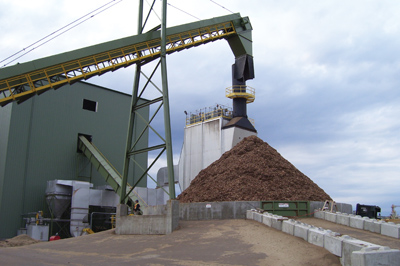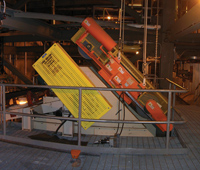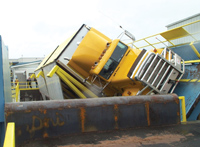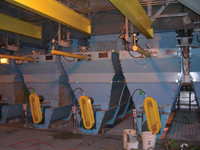
Move your Biomass
June 14, 2010
By Paul Janzé
Biomass is not an easy material to handle.
Biomass is not an easy material to handle. It appears in a myriad of species, forms, and sizes; it knits together, doesn’t flow well, consolidates and packs easily; it can have a wide range of moisture contents, basic and bulk densities, and calorific values; it will freeze; it is very dusty, catches fire easily, and is self-combustible; and it can contain all manner of contaminants. Conversely, wood pellets are uniform in size and moisture content and are free flowing, but they’re fragile, degrade easily, and require special handling.

|
|
| Covered storage is costly and only necessary in special circumstances. In most climates and locations, open storage piles are suitable.
|
Increasing numbers of power utilities are eyeing biomass as a source of fuel, primarily as a means of lowering CO2 emissions. New biomass boilers are being constructed, but many coal-fired boilers are being converted for co-firing with biomass or converted to 100% biomass. Biomass can be introduced into combustors as hog fuel, wood pellets, or injected as a powder. In Canada, many people and companies have extensive experience handling woody biomass in all its myriad forms. However, with the recent rush to use biomass for renewable energy, there are a lot of interested and well-intentioned but woefully inexperienced people vying for grants and proposing new projects, who have little or no experience with biomass.
Care must be taken in the design of your biomass handling system, whatever the form. The topic of design is as varied and complex as the material itself. My intent is to provide a description of things to consider when designing systems to handle woody biomass in the form of hog fuel and pellets.
A general tendency in most projects is to view the biomass handling system as the least glamorous part of the processing facility, and it is the area where most people try to cut costs. In any project, it is imperative to minimize costs, but the biomass processing system is not always the best place to do so.
DESIGN CONSIDERATIONS
The purpose of a biomass processing and handling system is to produce a feedstock that is consistent in constituents, size, and moisture content. Depending on the variety and form of the raw incoming material, processing systems can be quite complex. Many factors affect the design of the biomass system, including the type of facility, capital cost, location and space, type and required quality of material, method and timing of delivery, and climate.
 |
|
| Biomass delivery by barge is popular on the west coast and requires unloading equipment, a receiving hopper, and an onshore transport system. |
|
 |
|
| A self-cleaning magnet to remove tramp metal is best located over a pulley transition where the biomass is briefly suspended in air. |
Type of facility: The requirements for a facility that generates power for sale and must run 24 hours/day, 350 days/year at more than 95% uptime are much more rigorous than for a facility that uses the energy in-house and doesn’t suffer punitive damages from being off-line. A power producer must guarantee reliability; therefore, the fuel handling system must be reliable and in some cases redundant. Additionally, an independent cogeneration or combined heat and power facility must meet the requirements of both the host company and the power recipient.
Capital cost: Generally, the cost of the biomass handling system is not a constant percentage of the cost of whole facility; the smaller the facility, the greater the percentage cost of the fuel handling system in relation to the cost of the whole facility. Hence, there is greater pressure to reduce costs at smaller facilities, which often results in an inferior biomass handling system.
Location and space: A facility that is located in an urban area will likely be required to meet stricter environmental conditions than one isolated in the country, possibly including an enclosed biomass handling system and an odour control system. Biomass handling and storage requires considerable space. However, biomass-fired facilities are often located adjacent to other existing facilities and space can be at a premium. The available space has a tremendous effect on layout, and layout affects process operability and capital cost.
Incoming material: For the purposes of this article, the incoming material is pre-processed hog fuel or wood pellets. The handling systems for hog fuel and wood pellets would be quite different. For hog fuel, if possible, establish quality specifications with your biomass suppliers that have material, size, moisture content, and contaminant requirements. Establish a fuel sampling process to ensure quality. Wood pellets are usually manufactured to an industry standard.
If the quality and form of the incoming material is quite different from that of the required combustion fuel, then suitable processing equipment will be required on-site. It is my experience that the quality of incoming material will not always be as specified, and you must have the ability to deal with sub-quality material, either with equipment or procedures.
Delivery method and timing: How the material is delivered has a big effect on the biomass handling system. The systems required for truck, rail, and barge receiving and unloading are quite different and affect the layout, cost, and process. The delivery hours per day and days per week and interruptions in supply must also be considered. If the fibre source is shut down for prolonged periods, you will need more storage. If you have established supply contracts and your plant is down for a prolonged period, you will need more storage or will need to find another place that can take the material temporarily.
Climate: The biomass handling system for a facility located in northern Canada is much different from one on the west coast or one in the southern USA, so make sure your system designer has the appropriate experience.
Consider that an EPC (engineering, procurement, and construction) or design/build contractor will want to minimize his/her costs and often does so in the biomass processing area. To avoid this, hire a competent owner’s engineer with good biomass handling experience to do the conceptual design and write the design/build specification document for your biomass handling system.
ASSEMBLING THE PIECES
Generally, a hog fuel handling system requires the following subsystems.

|
|
| A new side-dumping tipper is effective at dumping Super B-Trains in cold climates. Photos: Paul Janzé |
Delivery/receiving system – The design of a truck receiving system depends on the type of truck being used to haul the biomass. Trucks can be self-unloading or non-self-unloading and can vary in size from a single trailer to Super B-Trains. Additionally, trucks tend to come during daylight hours, so the system must be designed to handle the peak flow.
A delivery receiving system using self-unloading trucks would include a truck scale, receiving hopper(s), and conveyors. Self-unloading trucks are available as end- or side-dumping or with live floors. For non-self-unloading trucks, a truck tipper is required. End-dumping tippers come in many configurations and sizes. A new side-dumping tipper has been shown to be very effective at dumping Super B-Trains in extreme cold climates.
Biomass delivery by rail requires a railcar scale, a railcar moving system, an unloading system, receiving hoppers, and conveyors to storage. Unloading systems can be as simple as mobile equipment or can be an end-dumper or, for high capacity, a roll-over dumper.
Biomass delivery by barge is popular on the west coast, and the unloading equipment varies. The best and most simple system uses mobile equipment that drives onto the barge via a ramp. The ramp is equipped with a receiving hopper that the mobile equipment fills. The hopper discharges into the conveyor system to storage. Other systems use dockside knuckleboom loaders or overhead cranes with clamshell buckets. Delivery by barge requires a docking or mooring facility, and possibly a warping system, that will accommodate water level changes.
Conveying systems – Belt and chain conveyors are most common because of their reliability. Generally, belt conveyors are less costly, but require more real estate because of their lower operating slope; however, belt conveyor slope is greatly reduced in cold climates to prevent material slippage. Conveyor speed should be kept quite low, less than 400 feet/minute. Belt loading should also be kept low to allow for oversized material. A belt weigh scale is often included.
Chain conveyors can operate at steeper slopes and are suitable for shorter or complicated runs. Avoid concave vertical curves. Use abrasion-resistant wear plates; however, rocks and grit tend to become embedded in the UHMW (ultra-high molecular weight polyethylene material) and will wear out chain quickly, so take care where you use them. Chain conveyors are costly, so resist the urge to undersize components to save on cost.
Avoid chute valley angles less than 45°. With some materials and in some conditions, even this is not steep enough.
Dilute phase pneumatic conveyors have long been used for transporting hog fuel. They are less costly than belt or chain conveyor systems, but have high power requirements and can generate a lot of fugitive dust.
 |
|
| The conveyor system from the reclaimer to the combustor feed bins should be variable speed to keep a near-constant level in the fuel bins. Photo: Paul Janzé |
Depending on the quantity of gross over-sized material rejected by the screen, there may or may not be a grinder/hog. If one is required, use a solid rotor, high inertia hog. Additionally, a metal detector belt should be installed before the hog to stop the feed if large pieces of tramp metal are detected.
Ferrous metal removal is essential and can be accomplished with a magnet. There are several magnet types and arrangements available, but the primary magnet should be self-cleaning. Avoid locating magnets in the cross-belt configuration, as the magnet will have difficulty removing metal that is underneath the load. Locate the magnet over a pulley transition, where the material is falling and is suspended. If possible, locate the magnet after the scalping screen to ensure that gross over-sized material will not jam between magnet and conveyor.
Storage and reclaiming system – The amount of storage required depends on: (1) the minimum amount of material required to maintain reliable operation; (2) the longest period of time that the flow of incoming material may be interrupted; and (3) the longest amount of time that the plant must continue to receive biomass when it is not consuming fuel.
Covered storage is costly and only necessary in special circumstances, e.g., in certain urban environments that mandate it, where the biomass is quite dry (less than 25% moisture content) and the climate very wet, or where the material is wet and there is a possibility of it freezing into lumps. In most climates and locations, open storage piles are suitable. Using wind fences can minimize dust issues.
Pile building can be accomplished by mobile equipment, over-pile belt or chain conveyors, slewing/luffing stackers, or pneumatic conveyors.
There are many storage and reclaim systems available and each has its place. Choosing the right system depends on: the material, the amount of storage required, the amount of live-storage required, the need for first-in/first-out flow, the ability to accurately meter the material, the need for mixing, and whether covered storage is required. I’ve found that fully automatic systems with 100% live-storage are prohibitively costly. Most projects that I’ve been involved in end up with something less, usually with enough live-storage for two to four hours of operation with no intervention.
Under-pile chain reclaimers are the lowest cost but have the smallest live-storage and tend to bridge. Ladder-stoker reclaimers have been in use for decades, are quite reliable, and have somewhat more live-storage. Depending on their size, over-pile rotary chain reclaimers can have live-storage of 12 to 24 hours, but are more costly.
Under-pile rotary screw reclaimers work well and do a good job of mixing, but are costly. Under-pile linear screw reclaimers also work well, do a good job of mixing, and can have the largest live-storage volume; unfortunately, they are very costly.
Live-bottom silos are suitable for storing some biomass such as wood chips, sawdust, pellets, and shavings, but are not recommended for hog fuel that contains a wide variety of sizes and stringy bark.
Conveying system to combustor – The conveying system to the combustor should include a weigh scale and tramp metal magnet. Additionally, a final scalping screen is recommended.
The type, quantity, and size of fuel feed bins is usually specified and supplied as part of the combustor package. The conveying system to the combustor should be capable of distributing the hog fuel uniformly so that the fuel bins remain full.
The conveyor system from the reclaimer through to the combustor feed bins should be variable speed and should remain full to minimize the lag time between the reclaimer and the fuel feed bins, thereby keeping a near constant level in the fuel bins. With today’s accurate bin level sensors controlling the feed conveyors to the combustor, it is no longer necessary to overfeed the bins and have a return conveyor system to the storage pile.
Dust collection systems – Hog fuel can be quite dusty, and you should provide for dust containment, suppression, and collection in your design. In some cases, high-efficiency cyclones may suffice, but in others, bag houses will be required. If the dust is sufficiently fine, spark detection, deluge systems, and abort gates may be required.
Rock/sand removal systems – Rock and sand removal systems are costly to install and operate and are rarely used. It is far better to prevent the rocks from entering the material flow than it is to remove them afterwards. Consequently, outdoor storage piles should be paved.
Bark presses/dryers – In most greenfield cases, it is best to design the combustor to suit the moisture content of the material being used as fuel, rather than attempting to dry the biomass. However, in some brownfield installations, bark dryers are necessary to reduce the moisture content of the biomass to a range that is compatible with the combustor. Sometimes on the west coast, biomass is so wet (over 60% moisture content) that bark presses are necessary to reduce the moisture content to 55%.
PELLET CONSIDERATIONS
Wood pellets are quite dry (12 to 15% moisture content), fragile, and break easily each time they are handled, so a material handling system for wood pellets has special requirements, including keeping them dry. The dust produced by degrading pellets is very fine, combustible, and explosive; therefore, dust collection systems with spark detection, deluge systems, and abort gates are essential.
Minimize the number of times the pellets are handled and use gentle handling equipment, including: self-unloading, live-floor trucks or bottom dump railcars; live-floor hoppers; conventional belt conveyors or steep angle belt conveyors; silos with gentle loading chutes and sloped bottoms to variable opening discharge chutes; belt conveyors to the fuel bins; screw distribution conveyors over the bins; and dust collection systems. If the wood pellets are being co-fired with pulverized coal, they will also need grinding or pulverizing before injecting into the combustor.
Paul Janzé has more than 30 years of experience in engineering design, project management, and equipment manufacturing and maintenance, primarily in the forest products and energy industries. His material handling experience includes biomass handling and processing of forest residuals, logs, lumber, chips, wood waste, straw and poultry litter, sludge and biosolids, municipal solid waste, and coal and ash handling. His specialties are fibre flow analysis, process optimization, and designing novel solutions to complex processing and handling problems. Visit Paul’s blog at www.advancedbiomass.com or contact Paul at Ausenco Sandwell in Vancouver, 604-684-9311, pjanze@ausencosandwell.com.
Print this page